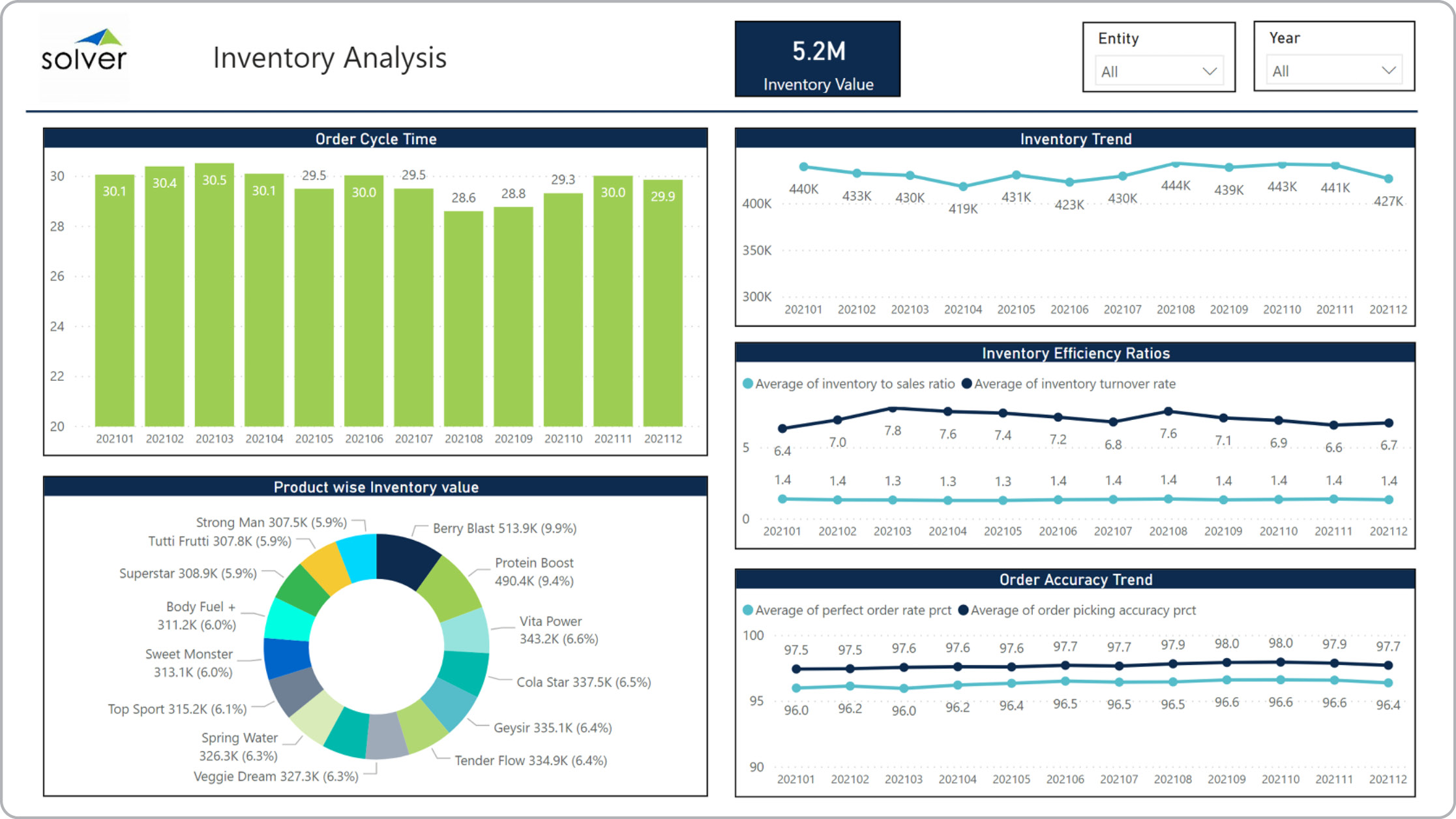Inventory Analysis Dashboard for Distributors
What is a
Inventory Analysis Dashboard
? Inventory Dashboards are considered operational analysis tools and are used by finance teams and inventory managers to analyze inventory KPIs. Some of the main functionality in this type of dashboard is that it provides a big picture view of essential metrics such as: 1) Order cycle time, 2) Inventory value by product/category, 3) Inventory trend, 4) Inventory efficiency ratio, and 6) Order accuracy trend. The filters seen on the top right of the dashboard enable drill down into individual warehouse locations and periods. You find an example of this type of dashboard below.
 Purpose of
Inventory Analysis Dashboards Distributors use Inventory Analysis Dashboards to give managers an easy and powerful way to monitor the inventory KPIs that matters most to them. When used as part of good business practices in a Financial Planning & Analysis (FP&A) department, an organization can improve and speed up its product purchasing- and inventory planning strategies, and it can reduce the chances that money is lost due to poor tracking of key trends and exceptions.
Inventory Dashboard
s Example Here is an example of a Inventory Analysis Dashboard with trends and value metrics. [caption id="" align="alignnone" width="2233"]
Purpose of
Inventory Analysis Dashboards Distributors use Inventory Analysis Dashboards to give managers an easy and powerful way to monitor the inventory KPIs that matters most to them. When used as part of good business practices in a Financial Planning & Analysis (FP&A) department, an organization can improve and speed up its product purchasing- and inventory planning strategies, and it can reduce the chances that money is lost due to poor tracking of key trends and exceptions.
Inventory Dashboard
s Example Here is an example of a Inventory Analysis Dashboard with trends and value metrics. [caption id="" align="alignnone" width="2233"]
 Example of an Inventory Analysis Dashboard for Distributors[/caption] You can find hundreds of additional examples
here
Who Uses This Type of
Dashboard
? The typical users of this type of dashboard are: Finance officers, analysts, inventory managers, purchasing managers.
Other Reports Often Used in Conjunction with
Inventory Analysis Dashboards Progressive Financial Planning & Analysis (FP&A) departments sometimes use several different Inventory dashboards, along with sales forecasts, detailed inventory reports, sales dashboards, purchasing reports and other management and control tools.
Where Does the Data for Analysis Originate From? The Actual (historical transactions) data typically comes from enterprise resource planning (ERP) systems like: Microsoft Dynamics 365 (D365) Finance, Microsoft Dynamics 365 Business Central (D365 BC), Microsoft Dynamics AX, Microsoft Dynamics NAV, Microsoft Dynamics GP, Microsoft Dynamics SL, Sage Intacct, Sage 100, Sage 300, Sage 500, Sage X3, SAP Business One, SAP ByDesign, Acumatica, Netsuite and others. In analyses where budgets or forecasts are used, the planning data most often originates from in-house Excel spreadsheet models or from professional corporate performance management (CPM/EPM) solutions.
What Tools are Typically used for Reporting, Planning and Dashboards? Examples of business software used with the data and ERPs mentioned above are:
Example of an Inventory Analysis Dashboard for Distributors[/caption] You can find hundreds of additional examples
here
Who Uses This Type of
Dashboard
? The typical users of this type of dashboard are: Finance officers, analysts, inventory managers, purchasing managers.
Other Reports Often Used in Conjunction with
Inventory Analysis Dashboards Progressive Financial Planning & Analysis (FP&A) departments sometimes use several different Inventory dashboards, along with sales forecasts, detailed inventory reports, sales dashboards, purchasing reports and other management and control tools.
Where Does the Data for Analysis Originate From? The Actual (historical transactions) data typically comes from enterprise resource planning (ERP) systems like: Microsoft Dynamics 365 (D365) Finance, Microsoft Dynamics 365 Business Central (D365 BC), Microsoft Dynamics AX, Microsoft Dynamics NAV, Microsoft Dynamics GP, Microsoft Dynamics SL, Sage Intacct, Sage 100, Sage 300, Sage 500, Sage X3, SAP Business One, SAP ByDesign, Acumatica, Netsuite and others. In analyses where budgets or forecasts are used, the planning data most often originates from in-house Excel spreadsheet models or from professional corporate performance management (CPM/EPM) solutions.
What Tools are Typically used for Reporting, Planning and Dashboards? Examples of business software used with the data and ERPs mentioned above are:
- Native ERP report writers and query tools
- Spreadsheets (for example Microsoft Excel)
- Corporate Performance Management (CPM) tools (for example Solver)
- Dashboards (for example Microsoft Power BI and Tableau)
 Corporate Performance Management (CPM) Cloud Solutions and More Examples
Corporate Performance Management (CPM) Cloud Solutions and More Examples
March 3, 2021
TAGS:
Reporting,
Solver,
report writer,
Microsoft,
template,
practice,
Acumatica,
visualization,
Netsuite,
Finance,
planning,
GP,
dashboard,
Inventory,
Business Central,
excel,
ax,
forecast,
Budget,
Dynamics 365,
analysis,
budgeting,
inventory value,
KPI,
Cloud,
distribution,
Software,
Tableau,
SAP,
example,
best,
Sage,
BC,
D365,
NAV,
Intacct,
CPM,
report,
SL,
Management,
dynamics,
Power BI,
inventory efficiency,
inventory dashboard,
inventory KPI,
order accuracy,
order cycle time,
inventory trend


